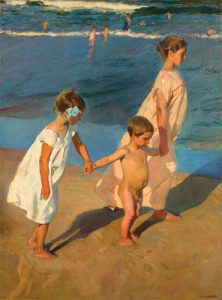Joaquín Sorolla: Going for a Swim

Al baño, 1908.
Oil and canvas. 200 x 150 cm
Signed on the lower right corner: ‘J. Sorolla Bastida / 1908′
The summer of 1908 was one of the most fruitful summers on the beaches of Valencia in Sorolla’s career, and this is one of his most prominent paintings among the extensive set from that year featuring children frolicking in the sun and water on the seashore.
It is a convergence of the best features of this genre, which is so closely identified with the oeuvre of this Valencian painter, who was at the height of his faculties and artistic conquests in this work. In it, two girls of differing ages are walking along the beach tenderly holding the hands of a smaller boy in the bright light of a Valencian sundown, which neatly casts the children’s shadows onto the surface of the sand.
Compared to the light-hearted triviality of this everyday scene, Sorolla offers a modernity that is truly surprising in its bold framing, in which he radically eliminated the horizon line to make the figures stand out over the enveloping background of sand and water. This stands as eloquent testimony of the incredible importance of photography on the master’s work, which he had assimilated with utter normality since his youth due to the decisive influence of his father-in-law, the prominent Valencian photographer Antonio García, with whom he was close. Thus, Sorolla revealed the depth of the shore through large swaths of colour, from the closest warm sand, followed by the bright strip just moistened by the water, reflecting the light blue of the sky, until the furthest distance, populated by bathers playing amidst the foam of the breakers.
On the other hand, the painting is a wonderful example of Sorolla’s special sensitivity towards his child models, who were treated here with a striking, almost monumental, presence, and who featured in many of his beach scenes, which are populated with naked boys and girls covered in loose robes billowing in the wind. In all of them, he conveyed the fullness of human enjoyment, in complete harmony with nature, in which the artist clearly felt the legacy of classical Greece conveyed via the waters of the Mediterranean that lapped at the coasts of his land.
Sorolla displayed this painting in 1909 in New York, where it was wildly successful. It was acquired then by Archer M. Huntington, an enthusiastic admirer of the Valencian painter’s works, who a few years later commissioned the large paintings in his Vision of Spain for the Hispanic Society of America, created by this magnate.
José Luis Diez, full member of the Royal Academy of History, PhD in Art History and curator in 2009 of the Joaquín Sorolla exhibition at the Museo del Prado.

